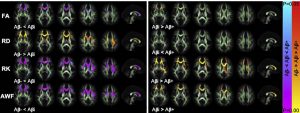 Patience and persistence, qualities research staff scientists have, pays off when a paper finally sees the light and is published. In this case, a project which was started at New York University School of Medicine during the postdoctoral work on microstructural MRI of human white matter, combining diffusion MRI and biophysical modeling completed by Ileana Jelescu has recently appeared in Elsevier Journal on Neurobiology of Ageing.
Patience and persistence, qualities research staff scientists have, pays off when a paper finally sees the light and is published. In this case, a project which was started at New York University School of Medicine during the postdoctoral work on microstructural MRI of human white matter, combining diffusion MRI and biophysical modeling completed by Ileana Jelescu has recently appeared in Elsevier Journal on Neurobiology of Ageing.
Ileana says, “As with any clinical study, it takes a very long time to finish the recruitment and to wrap up the analysis.”
Beta-amyloid plaques are the earliest pathological marker of Alzheimer’s disease but white matter integrity is also affected as early as the Mild Cognitive Impairment (MCI) stage. In this PET-MRI study of MCI and age-matched healthy controls, we used a PET tracer for amyloid to quantify plaques and diffusion MRI to characterize white matter microstructure and its integrity. We showed that going from low to intermediate amyloid burden was associated with reduced water mobility in white matter – a hallmark of inflammation – while going from intermediate to high amyloid burden was associated with much increased water mobility in the white matter – a hallmark of loss of structure and neurodegeneration. This nonmonotonic trend in biomarkers of white matter integrity is fully consistent with previous reports of bi-phasic trajectories in cortical thickness, cerebral blood flow and hippocampal connectivity in MCI patients, which all seem to point to two different (possibly inflammatory and neurodegenerative) stages of an incipient disease.”
Read the paper by Dong, Jelescu et al. here
Ileana Jelescu is currently a CIBM research staff scientist and the 14T MRI operational manager of the CIBM MRI -AIT Section at EPFL.
